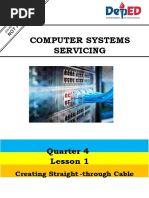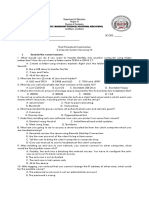System Unit Activity 2
Uploaded by
Keziah AliwanagSystem Unit Activity 2
Uploaded by
Keziah AliwanagJaaziah Kish Dy Galing LIVING IN I.
T ERA
BSA 1 ACTIVITY #2
PARTS OF THE SYSTEM UNIT
(INTERNAL AND EXTERNAL)
INTERNAL HARDWARE
1. Motherboard-Contains all of the connections that allow the carious other subsystems to
interact.
2. Central Processing unit (CPU)-The components that performs all calculations and
mathematical manipulations in a computer.
3. Read Only Memory (ROM)-The memory that computers used to store data and
instructions needed by the CPU for computer operation.
4. Disk Drive-Allows a computer to play CD’s or DVD’s.
5. Battery-The battery allows your computer to function. Without a battery you would not
be able to turn on.
6. Processor-The brain of the computer system.
7. Cables-The cables connect every electronic device together to connect the circuit and
allow everything to work.
8. Fan-The fan is a device that helps your computer cool down a lot easier by blowing
around the air in your laptop.
9. Heat sink- Necessary to have a CPU cooler. Without it, your CPU will quickly burn
itself out.
10. Modem-Connects hardware and signal.
11. Video card-Deals with PC gaming and high definition video and multiple displays.
12. Hard Drive-The primary method of storage in all desktop computer systems.
13. USB port-The USB port allows you to plug in another device that has a USB out and
connect it to your computer.
14. Ethernet port-a system connecting a number of computer systems to form a local area
network.
15. Serial Port-A connector by which a device that sends data one bit at a time may be
connected to a computer.
16. Random Access Memory-The most common computer memory.
17. Power Supply-The charger for the laptop that allows the user to charge their computer.
This puts more battery power into the computer so that it can last longer.
EXTERNAL HARDWARE
1. Microphone-Listens and captures or amplifies sound.
2. Webcam-Allows user to capture video or screenshots of themselves.
3. Monitor-Displays information for user on a desktop computer.
4. Screen- Displays information for the user on a laptop screen.
5. Keyboard-Lets the user type information.
6. Computer-An electronic device for storing and processing data.
7. Speakers-Project sounds on the computer.
8. Mouse-Allows the user to move the cursor on the computer.
9. Ports-Allows the user to plug in things to the computer to connect certain devices.
ASSEMBLE AND DISSASSEMBLE OF SYSTEM UNIT
DISSASSEMBLING A SYSTEM UNIT
1. Remove all the screws attached on the case to open it
2. Remove the screws designated in the power supply unit (PSU)
(Also, remove the wires which are connected to the PSU)
3. Remove the screws attached on the Hard disk drive
(Then, remove the wires attached from it)
4. The remove the RAM
5. Loosen up the screws attached in the CPU fan
(Then, carefully remove the CPU out)
6. Remove the screws attached on the mother board
7. Remove the wires
(Remove the motherboard out of the case)
ASSEMBLING A SYSYTEM UNIT
1. Put back the mother board into the tower
(Lock the mother board using the screws)
2. Attached the wires
3. Carefully put the CPU and the CPU fan bank to its place
4. Put the ARM and the HDD back to its holder
5. Put the PSU back
6. Close the case
7. Put back all the screws that has been remove in the case
You might also like
- DAF CF Electrical System (From Chassis 0E621376) Service Manual PDF100% (10)DAF CF Electrical System (From Chassis 0E621376) Service Manual PDF712 pages
- Technology Livelihood Education: (ICT) Computer System Servicing (CSS)No ratings yetTechnology Livelihood Education: (ICT) Computer System Servicing (CSS)31 pages
- COC1 Personal Computer Disassembly Assembly100% (2)COC1 Personal Computer Disassembly Assembly1 page
- Las Css 9 2nd Quarter - Padapada National HsNo ratings yetLas Css 9 2nd Quarter - Padapada National Hs3 pages
- 12ICT-CSS - 05 ORIENTATION and Network Design PresentationNo ratings yet12ICT-CSS - 05 ORIENTATION and Network Design Presentation16 pages
- Computer-Programmimg Java J-SHS Quarter-2 LAS-7 Week-7 FinalNo ratings yetComputer-Programmimg Java J-SHS Quarter-2 LAS-7 Week-7 Final18 pages
- TVL CSS CSS 12 Q3 M1 2 Plan and Prepare For Maintenance and Repair LAZNo ratings yetTVL CSS CSS 12 Q3 M1 2 Plan and Prepare For Maintenance and Repair LAZ13 pages
- Department of Education: Detailed Lesson PlanNo ratings yetDepartment of Education: Detailed Lesson Plan4 pages
- Computer System Servicing: Quarter 1 - Lesson 3No ratings yetComputer System Servicing: Quarter 1 - Lesson 312 pages
- Lesson 2 PLAN AND PREPARE FOR INSTALLATIONNo ratings yetLesson 2 PLAN AND PREPARE FOR INSTALLATION44 pages
- TLE CSS 10 Q3 Cont of q2 Lesson 9 ABValenzuela JRNo ratings yetTLE CSS 10 Q3 Cont of q2 Lesson 9 ABValenzuela JR16 pages
- Lesson 8: Installingand Configuring Computer SystemsNo ratings yetLesson 8: Installingand Configuring Computer Systems90 pages
- Computer Systems Servicing: Quarter 4 Lesson 1100% (1)Computer Systems Servicing: Quarter 4 Lesson 17 pages
- PPT - Router Setting and Wifi ConfigurationNo ratings yetPPT - Router Setting and Wifi Configuration36 pages
- Topics in Computer Hardware Servicing A. Hardware: 1. Installing Computer Systems and NetworksNo ratings yetTopics in Computer Hardware Servicing A. Hardware: 1. Installing Computer Systems and Networks16 pages
- CHAPTER 1-Introduction To Computer (Module)No ratings yetCHAPTER 1-Introduction To Computer (Module)19 pages
- Computer System Servicing-NC2: Reviewer Name of CandidateNo ratings yetComputer System Servicing-NC2: Reviewer Name of Candidate8 pages
- Lesson Plan in Tle Computer Hardware andNo ratings yetLesson Plan in Tle Computer Hardware and7 pages
- Learning Area Level Quarter Date: Computer Systems Servicing NC Ii Grade 12 FourthNo ratings yetLearning Area Level Quarter Date: Computer Systems Servicing NC Ii Grade 12 Fourth4 pages
- Quarter 3 - Module 1-W3: Computer Systems Servicing (CSS)No ratings yetQuarter 3 - Module 1-W3: Computer Systems Servicing (CSS)3 pages
- Css 11 Ncii Quarter 3 Module 4 Maintain Hand ToolsNo ratings yetCss 11 Ncii Quarter 3 Module 4 Maintain Hand Tools16 pages
- Technology Livelihood Education: (ICT) Computer System Servicing (CSS)100% (1)Technology Livelihood Education: (ICT) Computer System Servicing (CSS)31 pages
- This Is Subject For Revision. I Will Find Time To Finish This Thread. Stay Updated. I Will Provide Step by Step Procedure in Each Area. God Bless!No ratings yetThis Is Subject For Revision. I Will Find Time To Finish This Thread. Stay Updated. I Will Provide Step by Step Procedure in Each Area. God Bless!3 pages
- Parts of Back Panel Ports: Computer Monitor Audio USBNo ratings yetParts of Back Panel Ports: Computer Monitor Audio USB2 pages
- Quarter 3 - Module 1-W4&W5: Answer & Submit This Page. (W4-1)No ratings yetQuarter 3 - Module 1-W4&W5: Answer & Submit This Page. (W4-1)11 pages
- Information and Communications Technology 8 Quarter 1 - Module 1: Lesson 1 Title:History of Programming LanguageNo ratings yetInformation and Communications Technology 8 Quarter 1 - Module 1: Lesson 1 Title:History of Programming Language18 pages
- Computer Systems Servicing: Nformation and Communications TechnologyNo ratings yetComputer Systems Servicing: Nformation and Communications Technology17 pages
- CSS - 06-Week 5 - Module 5 - Setting-Up Remote AccessNo ratings yetCSS - 06-Week 5 - Module 5 - Setting-Up Remote Access5 pages
- Saint Paul University Surigao College of Business and Technology Grading SystemNo ratings yetSaint Paul University Surigao College of Business and Technology Grading System9 pages
- St. Paul University Surigao: Knowledge and Common SenseNo ratings yetSt. Paul University Surigao: Knowledge and Common Sense3 pages
- It'S More Fun in Surigao: FEBRUARY 27, 2020No ratings yetIt'S More Fun in Surigao: FEBRUARY 27, 20203 pages
- Total Common Dividend Numbers of Shares (Common) Dividend Per Share Market ValueNo ratings yetTotal Common Dividend Numbers of Shares (Common) Dividend Per Share Market Value4 pages
- Appreciation: Discussion Point (Group) Module 5 & 650% (2)Appreciation: Discussion Point (Group) Module 5 & 610 pages
- St. Paul University Surigao: Name: - DateNo ratings yetSt. Paul University Surigao: Name: - Date2 pages
- Gregorio Del Pilar (Goyo) : November 14, 1875-December 2, 1899No ratings yetGregorio Del Pilar (Goyo) : November 14, 1875-December 2, 189934 pages
- St. Paul University Surigao: Lyca Mae G. Galanida BSA - 101No ratings yetSt. Paul University Surigao: Lyca Mae G. Galanida BSA - 1015 pages
- Binary Subtraction: St. Paul University SurigaoNo ratings yetBinary Subtraction: St. Paul University Surigao7 pages
- ACS800 04 Technical Manual 0 55kW To 160kWNo ratings yetACS800 04 Technical Manual 0 55kW To 160kW136 pages
- Pulsar Analogue Quartz Watch With Alarm Chronograph Timer: Modes and Displays C A L - N 9 4 4, N 9 4 5 FeaturesNo ratings yetPulsar Analogue Quartz Watch With Alarm Chronograph Timer: Modes and Displays C A L - N 9 4 4, N 9 4 5 Features13 pages
- 777D and 773E Off-Highway Truck Electrical System CAT Detect Object Detection100% (1)777D and 773E Off-Highway Truck Electrical System CAT Detect Object Detection2 pages
- Boracay EUR AQ09T U0 IBIM 32447A E 3.19.11No ratings yetBoracay EUR AQ09T U0 IBIM 32447A E 3.19.1143 pages
- Service Manual: Central Air ConditioningNo ratings yetService Manual: Central Air Conditioning151 pages
- XH10P - XH15P XH20P - XH25P: Installation and Operating InstructionsNo ratings yetXH10P - XH15P XH20P - XH25P: Installation and Operating Instructions1 page
- 3500B Engine For Electrical Power Conversion Generation (EPG) With SwitchgearNo ratings yet3500B Engine For Electrical Power Conversion Generation (EPG) With Switchgear2 pages
- Baseband 6630 Installation Procedures - MOPNo ratings yetBaseband 6630 Installation Procedures - MOP10 pages
- Surface Well Control Equipment and Their UsesNo ratings yetSurface Well Control Equipment and Their Uses18 pages
- VMAX Architecture: - 1-8 Symmetrix V-Max EnginesNo ratings yetVMAX Architecture: - 1-8 Symmetrix V-Max Engines7 pages




















































































































